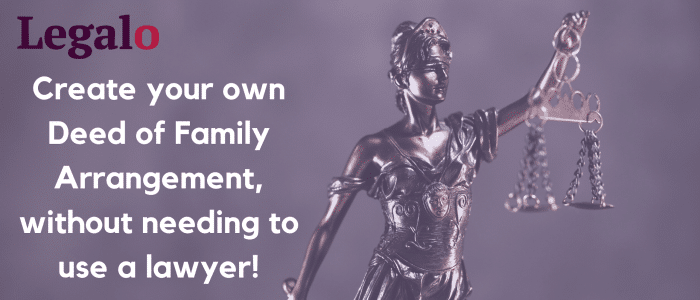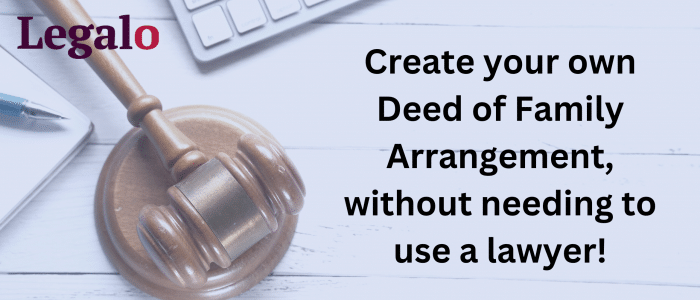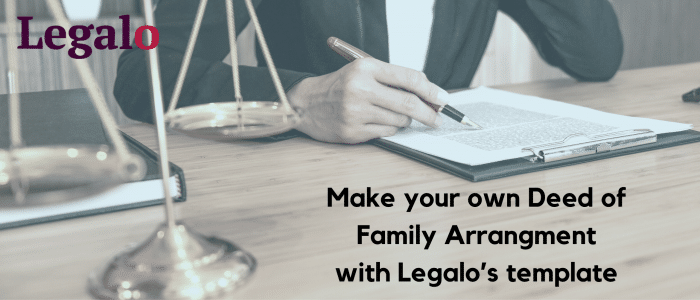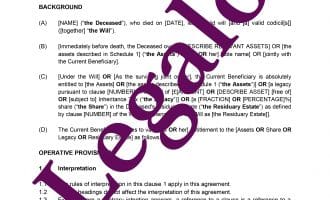Deed of Family Arrangement
Our Deed of Family Arrangement template:
- Easy-to-use template precedent
- Vary the terms of a Will after death
- Full guidance notes included with the download
- Drafted by a UK Solicitor for reliability
- Our 100% money back satisfaction guarantee

How Does It Work?
-
1. Download
-
2. Edit
-
3. Print
-
4. Sign
A Deed of Family Arrangement is a deed that can be created and put in place to vary the terms of a Will after the death of the person who left the will. Its formal name is a ‘Deed of Variation of a Will’.

About our Deed of Family Arrangement Template
Provided that the beneficiaries that will be affected by the variation agree, then the will can be varied so that the gifts that are passing under the terms of the will can be varied. There are many reasons for wishing to put in place a Deed of family arrangement.
If one or more of the beneficiaries under the will that you are considering have agreed to vary the terms of the gift left to them, so that all or part of it passes to another party, then use this precedent template to achieve that.
Using our Deed Template
A UK practising solicitor has drafted our precedent template, to ensure that it is accurate and reliable. It is available in Microsoft Word format. Once created, you can also save it to PDF format if you wish.
We provide a detailed guide to the template, which we include with your download. Once you download the template you simply need to edit the sections of the template that have square brackets – [ ]. You just need to edit these areas to include the information that is specific to your situation.
Once you have completed the Deed, you can then print it. It is then ready for signing. Ensure all the beneficiaries that the variation affects agree to it and sign the Deed.
What if there was no Will?
If the deceased person died without leaving a will, then their property will pass under the Intestacy Rules. You can still change who will receive the property of the deceased person, but, in this situation, you need to use a document called a ‘Deed of Variation on Intestacy‘, which you can also download from our website.

FAQs on these Deeds
Below, we address the most popular questions on this subject from the Internet.
What is a Deed of Family Arrangement in the UK?
A Deed of Family Arrangement is a legal document you use to change the distribution of assets in a deceased person’s estate. It allows beneficiaries to alter the terms of a will to distribute the assets differently than originally specified. It must be signed by all affected parties.
Can I write a Deed of Family Arrangement myself?
While you can draft a deed of family arrangement yourself, it is a complex legal document that can have significant financial and legal implications. This is why we recommend starting off with our deed template, which can be downloaded from Legalo quickly and easily. All you need to do is fill in the details!
What is the difference between a Deed of Family Arrangement and a Deed of Variation?
These are two different names for the same document. On our website, we have a page for each just to cover both Google searches. The document you receive will be the same in each case.
What is the Deed of Family Arrangement on intestacy?
A Deed of Family Arrangement on intestacy is a legal document you would use when a person dies without leaving a valid will (dying “intestate”). In this context, you use the document to rearrange the distribution of the deceased person’s assets among the beneficiaries. When someone dies intestate, the law determines how their estate will be distributed, based on statutory rules. However, there may be situations where the default distribution under intestacy laws does not align with the wishes or needs of the deceased person’s family members. This is where you can use a deed of variation on intestacy. At Legalo, we call our template for this a Deed of Variation for Intestacy.
Does a Deed of Family Arrangement avoid inheritance tax?
A Deed of Family Arrangement itself does not avoid inheritance tax liability in the deceased’s estate, unless you divert the inheritance to a charity. However, where it can potentially save on inheritance tax is in the estate of the person who is diverting the legacy. If that person were to die within 7 years of making the gift, then, without a deed of variation, the value of the gift would be treated as an asset still in their estate when they died. This might increase their estate’s inheritance tax liability, so using the deed of variation can potentially make a saving here.
Is a Deed of Family Arrangement legally binding?
Yes, a Deed of Family Arrangement is legally binding when properly executed and in the case that it meets all legal requirements set by HMRC. This means that it must be a written document, signed by all relevant parties, and must include all of the information needed to distribute assets fairly among beneficiaries. Using Legalo’s template helps you to meet all the HMRC requirements.
However, you might invalidate the Deed if the person diverting their inheritance is a bankrupt or otherwise insolvent. If they use the deed to divert their inheritance then one could see this as cheating their creditors, and a trustee in bankruptcy could reverse the effect of the deed.
What are the disadvantages of a Deed of Family Arrangement?
There are not any real downsides to using a deed of variation or a Deed of Family Arrangement. There’s only a small cost (if you use a Legalo template) and only a small amount of time involved.
What are the advantages of a Deed of Family Arrangement?
The whole point of a deed of family arrangement is that HMRC give you a tax break for this. So why not use it? This is a neat and simple way to divert an inheritance or legacy or part of it.
How long does it take for a solicitor to do a Deed of Family Arrangement?
In a straightforward case, where all parties are readily available and there are no significant complications, it can typically take a couple of months to complete such a deed when using a solicitor. Depending on circumstances and several factors, such as their waiting list, this can often take even longer. So using a Legalo template can eliminate a lot of this extra stress, waiting time and help to speed up the process, as well as save you a tidy sum in legal fees.
When would a Deed of Family Arrangement be used?
You would typically use a Deed of Family Arrangement in the following situations:
- To redistribute assets in a deceased person’s estate among beneficiaries.
- To address unequal distributions, disputes, or changing family circumstances.
- For tax-planning purposes, to reduce the risk of future inheritance tax liability.
- To protect assets from creditors or legal claims (you need to be solvent in order to divert your inheritance validly).
- To make charitable donations from the estate (this can also benefit the estate by reducing its liability to inheritance tax).
What is the alternative to a Deed of Family Arrangement?
The first alternative to a deed of family arrangement is to follow the deceased’s original will or the rules of intestacy, without making any changes. If you need to make changes, then the second alternative to the deed is to simply make a gift. In tax terms, HMRC call this a “lifetime gift”. However, HMRC will add back the value of the lifetime gift to the gift-maker’s estate if they die within 7 years of making the gift. Therefore, this might add to their estate’s inheritance tax liability. This is the main benefit of using this deed – it avoids this 7-year rule and possible extra inheritance tax.
Who pays for a Deed of Family Arrangement?
The costs of a deed of family arrangement are typically paid from the deceased’s estate, but technically the current beneficiary (the person wanting to divert the inheritance) should pay for it. These expenses may include legal fees for drafting and executing the deed, as well as any applicable registration or administrative costs. In some cases, beneficiaries who benefit from the arrangement may agree to share the costs, but it’s common for the estate to cover these expenses.


